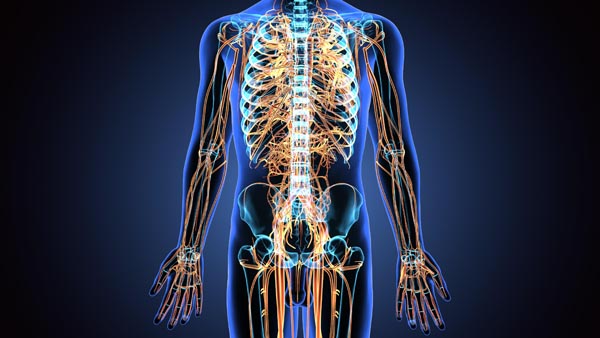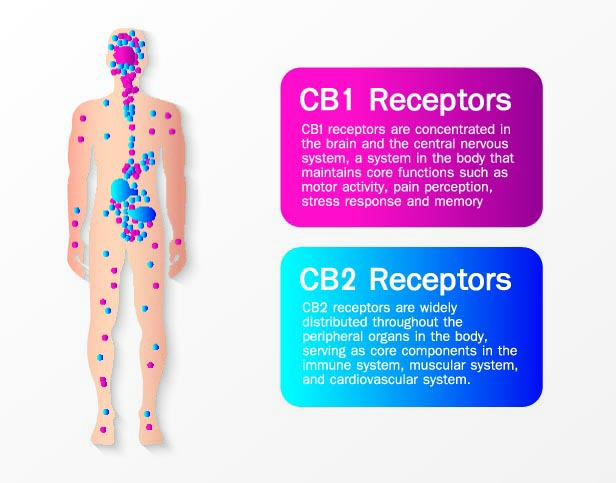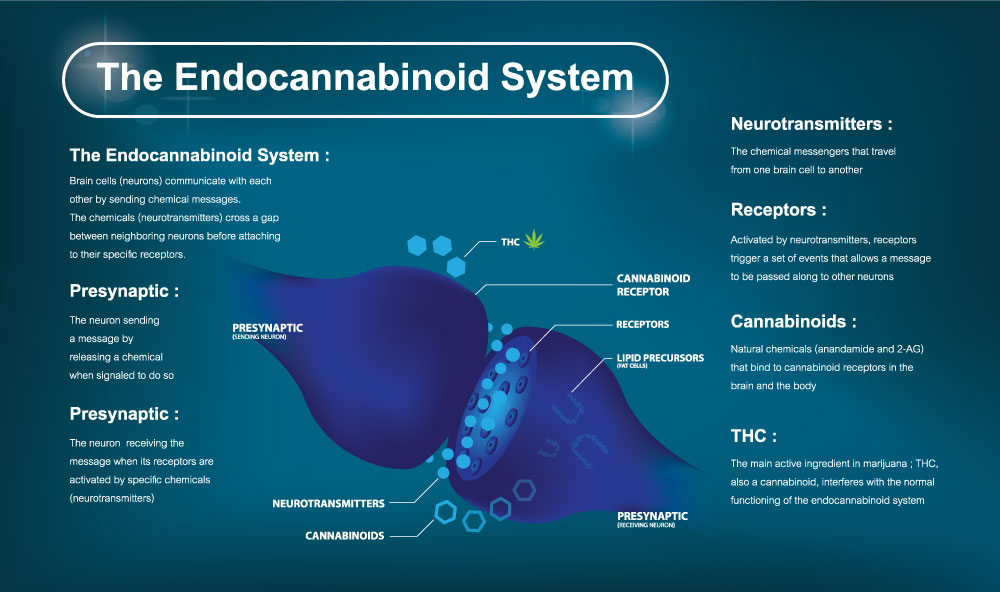The Endocannabinoid System
The systems of the human body are made up of multiple organs that work together to perform specialized functions.
An example is how the different organs of your digestive system work together to break down food. Groups of organ systems work together to create complete, functional and healthy organisms.
There are 11 major organ systems, which include the circulatory, respiratory, digestive, excretory, nervous and endocrine systems. The immune, integumentary, skeletal, muscle and reproductive systems are also systems of the human body.
One system that you may not be aware of is the Endocannabinoid System.
What is the Endocannabinoid System?

The Biological Psychiatry Journal defines the Endocannabinoid System as:
A widespread neuromodulatory system that plays important roles in central nervous system development, synaptic plasticity, and the response to endogenous and environmental insults.
Basically, what this complicated medical definition states is that the Endocannabinoid System uses chemical messages, that are sent to neurons, to regulate the development of our central nervous system. This allows cells to communicate throughout the body, helping the body to respond to threats both inside and outside.
In short, the Endocannabinoid System exists to help your body maintain balance.
What the Endocannabinoid System is Not
After the discovery of the Endocannabinoid System in the early 90s, a rumor began circulating that stated the sole purpose of the Endocannabinoid System was to utilize cannabis in our bodies.
This is very far from the truth. While cannabis does work in conjunction with the Endocannabinoid System, we all have this system in place naturally, even if you have never used cannabis before.
The Endocannabinoid System is still “New”
If you are wondering why you did not learn more about this system in health or biology class years ago, it is because scientists only discovered it in humans in 1992.
Even though the Endocannabinoid System was discovered almost 20 years ago, there is still a significant amount of scientific research that needs to be conducted in order to have a better understanding of how this system works.
Additional research needs to be focused on how the Endocannabinoid System integrates with the other major organ systems of the human body.
Aside from being relatively “new,” what may interest you even more about the Endocannabinoid System is the fact that humans are not the only species who have it.
Every animal that has a spine has an Endocannabinoid System!
Understanding how recent the discovery of the Endocannabinoid System is, sheds light on how much research still needs to be done before we can understand all the possible medical benefits of cannabinoids and cannabis in general.
How does the Endocannabinoid System Work?
 Explaining the function of the Endocannabinoid System is something that scientists have been debating for almost as long as they have known that it has existed.
Explaining the function of the Endocannabinoid System is something that scientists have been debating for almost as long as they have known that it has existed.
One of the best ways that science has explained the Endocannabinoid System is to think of it as a series of locks and keys.
There are numerous receptors in many of the cells in the human body. These receptor cells are currently classified as CB1 and CB2 receptors. You can think of these receptors as the “locks” of the Endocannabinoid System.
Our bodies naturally produce endocannabinoids that serve as the “keys” to these cellular locks. Once the endocannabinoids “unlock” these receptor cells, the cells are then able to transmit messages that help the systems of the body communicate and self-regulate.
For example, endocannabinoids help to regulate things like your body’s temperature and pH levels, as well as pain control, stress management, triggering immune responses, neuroprotection, appetite and even motor coordination.
The interesting thing is that these receptor cells are found all throughout your body with CB1 receptors being primarily located in the brain and central nervous system, while CB2 receptors are mainly found in the immune system, as evidenced in this study.
When the body is functioning at optimal levels, it produces endocannabinoids that serve as the “keys” to unlocking the receptor cells so that they can communicate with one another, promoting balance throughout all of the body’s systems.
With one system regulating so much of your body’s internal communications, it is easy to see how ailments that affect the Endocannabinoid System can begin to throw multiple systems out of balance. When this happens, issues like chronic pain, inflammation and an overactive immune response can often manifest.
This is where the role of phytocannabinoids contained in cannabis come into play.
What Happens When Your Endocannabinoid System does not work Correctly?
There are some ailments that are believed to be related to a condition known as Clinical Endocannabinoid Deficiency (CED). For more information on this condition and some of the ailments associated with it, please visit our article on Clinical Endocannabinoid Deficiency.
How Cannabis Affects Your Endocannabinoid System
The human body creates its’ own “keys” using endocannabinoids that bind to receptor cells, in turn causing the transmission of various chemical messages throughout the body’s systems.
When you consume cannabis, you are basically providing your body with a spare set of keys that can also unlock the same receptor cells.
Modern scientific research has produced some studies showing significant promise for medical cannabis therapy. One such study showed that phytocannabinoids (cannabinoids contained in the cannabis plant) were effective in treating chronic pain, nerve pain and inflammation related pain experienced from ailments like arthritis.
Another study showed that the cannabinoid CBD was effective at reducing seizure activity associated with epilepsy.
However, there is one thing that you must be aware of when it comes to trying cannabis therapy yourself, cannabis affects every individual differently.
Why Does Cannabis Affect Everyone Differently?
There are cannabinoid receptors found throughout the human body and depending on a variety of factors, the number and size of the receptors that we have is different from individual to individual.
Two people consuming the exact same strain of cannabis from the exact same cannabis plant may have completely different results. This is because each individual processes cannabinoids in their own unique way.
While one person may have significantly more cannabinoid receptors in their body and be far more sensitive to cannabis, someone else may have fewer receptors and be less sensitive.
We here at Kanteeva always recommend starting slowly when it comes to consuming cannabis. It is important that you know how your own individual Endocannabinoid System will process cannabis, specific cannabis strains and different cannabis products. Always consult a healthcare provider who has experience with medical cannabis. Also, read the Kanteeva article "10 Questions to Ask Your Healthcare Provider" to help get the conversation started.
Final Thoughts
 The Endocannabinoid System is amazing thanks to its ability to help your body’s other systems communicate with one another at a cellular level. As more scientific research is conducted in the future, we will gain a deeper understanding of how phytocannabinoids interact with the Endocannabinoid System; there are many potential medical breakthroughs on the horizon.
The Endocannabinoid System is amazing thanks to its ability to help your body’s other systems communicate with one another at a cellular level. As more scientific research is conducted in the future, we will gain a deeper understanding of how phytocannabinoids interact with the Endocannabinoid System; there are many potential medical breakthroughs on the horizon.
In the meantime, current research is showing us how the Endocannabinoid System can be utilized to reduce a variety of symptoms from many different ailments. Firsthand evidence from the testimonials of medical cannabis patients have stated for years that cannabis has been able to help relieve many symptoms related to various ailments.
Hopefully, after reading this article you have a stronger understanding of what the Endocannabinoid System is and how cannabis can affect it.
If you have any additional questions, comments or stories, please leave them below and a member of the Kanteeva team will reply as soon as possible. Also, be sure to join our community to see what other users are finding success with, what new research has been completed and much more.
Learn. Share. Connect.

